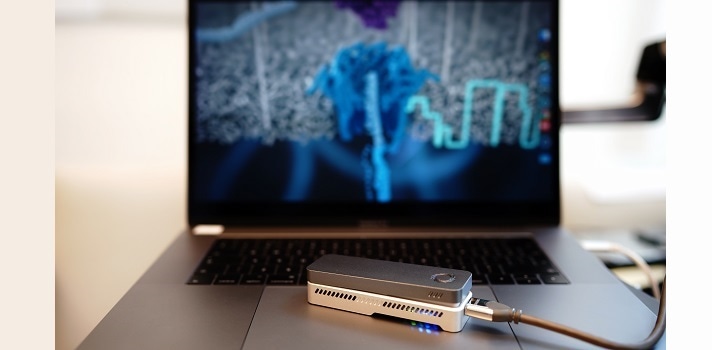Rare genetic mutations occurring in a reservoir of cells cannot be detected by existing sequencing techniques because these methods do not have the required sensitivity.

The sequencing setup for the study: an Oxford Nanopore sequencer and a laptop computer. The screen in background shows the DNA strand fed through the sequencer. Image Credit: © 2020 KAUST Mo Li.
However, the detection of these gene mutations is specifically significant, for instance, in the early detection of cancer. Now, a team of researchers from King Abdullah University of Science and Technology (KAUST) has designed a new method, known as targeted individual DNA molecule sequencing, or IDMseq, that can precisely identify a single mutation in a reservoir of 10,000 cells.
Most significantly, the researchers were able to use the IDMseq technique to establish the frequency and number of mutations induced by the CRISPR/Cas9 gene editing tool in human embryonic stem cells. Clinical trials are ongoing to test the safety of CRISPR for treating specific genetic disorders.
Our study revealed potential risks associated with CRISPR/Cas9 editing and provides tools to better study genome editing outcomes.”
Mo Li, Study Lead and Bioscientist, King Abdullah University of Science and Technology
The sequencing technique IDMseq involves fixing a special barcode to each DNA molecule present in a cell sample and subsequently producing a huge number of copies of every molecule through a polymerase chain reaction (PCR). The same barcode as the original ones are carried by copied molecules.
Variant analysis with a unique molecular identifier for long-read technology, VAULT for short, is a bioinformatics tool kit that subsequently decodes the barcodes and places analogous molecules inside their own “bins,” with each bin denoting one of the original molecules of DNA. The VAULT kit makes use of a combination of algorithms to identify mutations in the bins.
The procedure works particularly well with third-generation long-read sequencing technologies and helps investigators identify and establish the frequency of each type of mutations, right from modifications in single DNA letters to massive insertions and deletions in the original molecules of DNA.
The method successfully identified an intentionally caused gene mutation that was combined with a cluster of wild-type cells at ratios of 1:100, 1:1,000, and 1:10,000, and also reported its frequency correctly. The team also applied the IDMseq method to examine the mutations induced by CRISPR/Cas9 genome editing.
Several recent studies have reported that Cas9 introduces unexpected, large DNA deletions around the edited genes, leading to safety concerns. These deletions are difficult to detect and quantitate using current DNA sequencing strategies. But our approach, in combination with various sequencing platforms, can analyze these large DNA mutations with high accuracy and sensitivity.”
Chongwei Bi, PhD Student, King Abdullah University of Science and Technology
The tests identified that huge deletions were responsible for 2.8%–5.4% of Cas9 editing results. They also found that single-base DNA variants in the edited region reflected a three-fold increase.
This shows that there is a lot that we need to learn about CRISPR/Cas9 before it can be safely used in the clinic.”
Yanyi Huang, Peking University
Huang is an international collaborator, jointly supported by KAUST.
According to the team, the IDMseq technique can presently sequence only a single DNA strand, but additional studies to allow double-strand sequencing could further boost its performance.
Source:
Journal reference:
Bi, C., et al. (2020) Long-read individual-molecule sequencing reveals CRISPR-induced genetic heterogeneity in human ESCs. Genome Biology. doi.org/10.1186/s13059-020-02143-8.